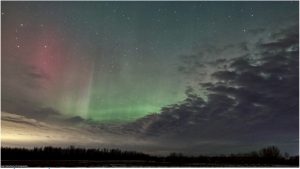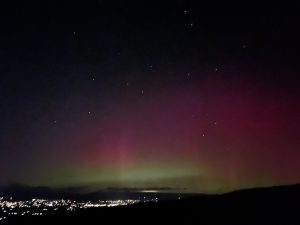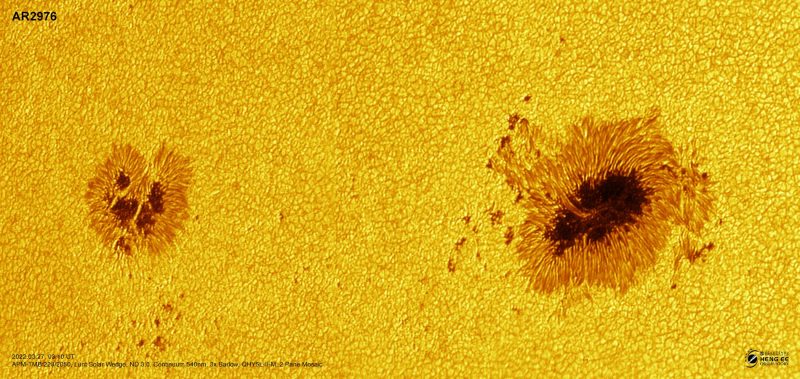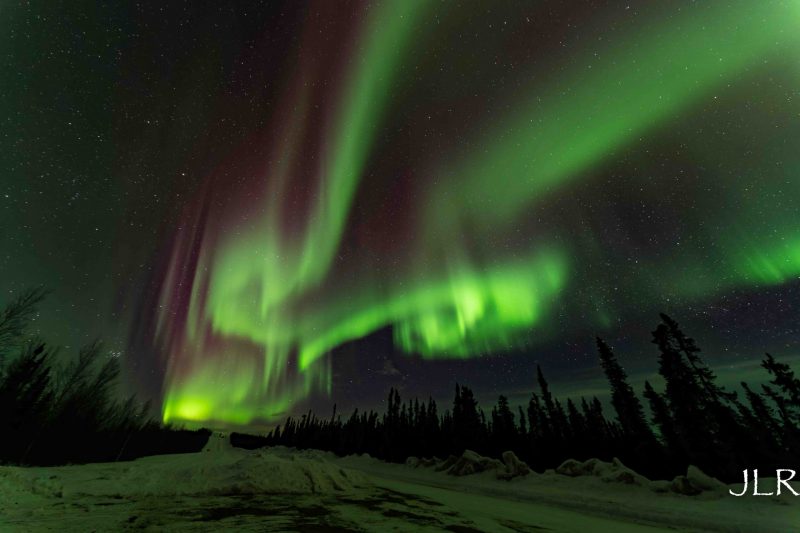
Week of March 28 to April 3, 2022: Strong flares and auroras
What a week for sun activity! We’ve seen multiple flares, and even an X-flare and a near X-flare. Now the sunspot regions that produced much of that activity are going out of sight, with the sun’s rotation carrying them out of view. But some new active regions 2978 and 2981 have yielded some filament flares and beautiful prominences.
Keep um coming! Impulsive M4.3 from AR2975! Shortwave radio blackout over the Americas. The previous M flare was much longer, called a gradual flare. Gradual flares are more often associated with CMEs. Like the Energizer Bunny! Keeps on going. ??? pic.twitter.com/8oRDPoPyCa
— Dr. C. Alex Young (@TheSunToday) April 2, 2022
A look back at March 25 to April 2
What an exciting week! Here is a look back at the Sun’s northern hemisphere focusing on AR2975 from March 25 – April 2. Starting from SDO 304->171>193->131. ~50,000 K to 10+ million K. Hot Hot Hot with lots of fun Sun action! ???? pic.twitter.com/pgIr7dv0yp
— Dr. C. Alex Young (@TheSunToday) April 2, 2022
This week’s sun and aurora images from EarthSky’s community








March 31: Watch for auroras
Sunspot regions AR2978 and in particular AR2975 produced a number of solar C-class and M-class flares on March 28. Sun experts have seen a “cannibal” CME (two coronal mass ejections, or CMEs, combined) coming our way, anticipated to reach Earth on March 31, 2022. Strong geomagnetic storms (G3-class) will probably result in bright auroras. The auroras should reach down to latitudes like those in the northern U.S. All that in addition to the X flare that happened on March 30! See below.
X AGAIN?! An Xflare from AR2975 again or at least an M9.6 (M10 = X1) is underway. Will it every end? ?? Seen in SDO 131 and GOES X-ray. There is also a radio blackout over the Americas! pic.twitter.com/RJATC3skT3
— Dr. C. Alex Young (@TheSunToday) March 31, 2022
A snapshot from STEREO A showing the CME from the X1.38 flare heading in the direction of Earth. Awaiting more data and detailed analysis to see if it will impact us and kick up the space weather at Earth. Turning out to be an exciting time thanks to AR2975. ??? pic.twitter.com/gsQkFg5qy1
— Dr. C. Alex Young (@TheSunToday) March 31, 2022

March 30: X-flare!
Sunspot AR2975 blasted out an X1.38 flare just now (at 17:37 UTC on March 30, 2022). It created an R3 level radio blackout over the Americas. For those who don’t know, heliophysicists use a classification system that divides solar flares according to their strength. The smallest ones are A-class, followed by B, C, M … and finally X. So X-flares are the strongest solar flares.
The source of the March 30 X-flare – sunspot AR2975 – has already sent at least two coronal mass ejections (CMEs) toward Earth this week (see below).
Generally speaking, if X-flares are Earth-directed, they and their associated CMEs can create strong geomagnetic storms that can harm satellites in Earth orbit, communications systems, and power grids. This X-flare is not expected to cause catastrophic results! But it should cause a beautiful auroral display.
X FLARE!!! BAM!! AR2975 just blasted out an X1.38 which created an R3 level radio blackout over the Americas. WOW! Exciting! AR2975 has not failed to impress! ??? pic.twitter.com/8eKMnW3Avn
— Dr. C. Alex Young (@TheSunToday) March 30, 2022

Earlier on March 30: Geomagnetic storm watch
Activity on the sun earlier this week prompted NOAA to issue a watch for a strong geomagnetic storm. NOAA is now projecting strong storms with a G-3 classification. That means we might get auroras as far south as Illinois, New York and Oregon. Updated watch times suggest the “cannibal CME” from two combined storms will strike at 0 UTC on Thursday, March 31. That is 7 p.m. CDT on Wednesday, March 30, for us in the Americas.
Aurora alert!
NOAA has updated its March 31 geomagnetic storm watch to G3 with a G1 watch for March 30 and a G2 watch for April 1. Waiting for those to CMEs to get to us. Then maybe auroras as far south as e.g. Illinois, New York, and Oregon in the US. ???? pic.twitter.com/UA7CTxEUfT
— Dr. C. Alex Young (@TheSunToday) March 29, 2022
March 29: NOAA models show ‘cannibal’ CME
NOAA computer modeling suggests that the two CMEs headed for Earth – from the high level of activity on the sun earlier this week – will combine, creating what is called a cannibal CME (one CME “eats” the other). The cannibal CME is expected to strike Earth’s magnetic field around 3 UTC on March 31 (10 p.m. CDT on March 30).
The NOAA SWPC has modeled the two coronal mass ejections which were launched during yesterday’s M-class activity. The ENLIL model predicts a combined impact (second CME is faster than the first one) just after midnight UTC on 31 March. Moderate G2 storm conditions are possible. pic.twitter.com/dnon5fqQAS
— SpaceWeatherLive (@_SpaceWeather_) March 29, 2022
March 28: M-flares and C-flares
Active sun! Sunspot AR2975 produced multiple M-class flares on March 28, 2022. The same sunspot also produced severals C-class flare that verged on M status, at C9.8.
The biggest M-flare came earlier in the day, at 11:30 UTC. The solar flare peaked at M4.1. This eruption produced an R1 level shortwave radio blackout over Africa. NOAA reported a burst of radio waves indicating a possible fast CME. There is also a sudden increase in solar protons. The protons reached the level of an S1 proton storm alert from NOAA. While the flare created a radio blackout at the peak of the flare, the proton event creates a delayed radio blackout over Earth’s poles. The event also produced a solar tsunami (EIT wave). Stay tuned for more updates on how this will affect Earth.
Now that is some action! AR2975 has produced 6 Mflares, 10+ Cflares, and two halo CMEs heading our way. An exciting couple of days and soon maybe here at Earth when the CMEs get here. Together they will be better. ?Get your aurora watching eyes ready! ?? pic.twitter.com/4QhXwkvMC4
— Dr. C. Alex Young (@TheSunToday) March 29, 2022

Bottom line: Sun activity was high during the week of March 28 to April 3, 2022. Multiple CMEs came Earth’s way. Some auroral displays at latitudes like those in the northern U.S. An X-flare!
The post Sun activity: An exciting week! first appeared on EarthSky.
0 Commentaires